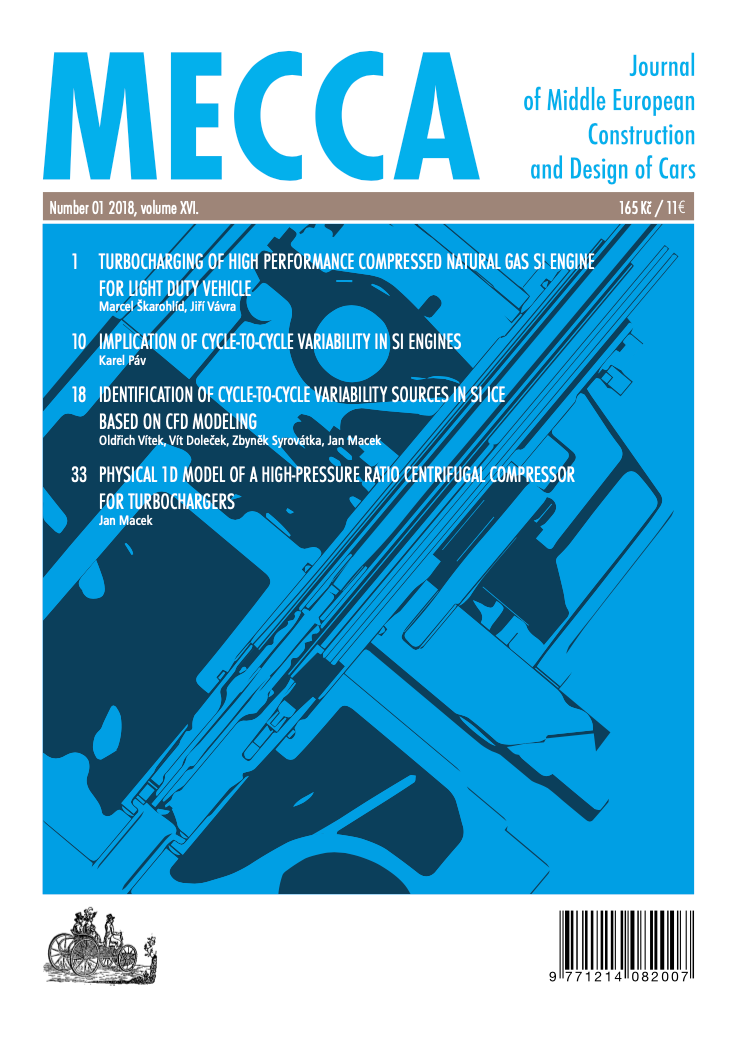TURBOCHARGING OF HIGH PERFORMANCE COMPRESSED NATURAL GAS SI ENGINE FOR LIGHT DUTY VEHICLE
Keywords:
CNG Engine, Miller cycle, Valve timing, TurbochargerAbstract
Natural gas as an automotive fuel has many benefits in comparison with traditional fossil fuels. Favorable anti‐knock properties of methane allow us to utilize higher boost levels and the engine power than that of gasoline engines. High level of intake boosting make possible to achieve loads, comparable to the state‐of‐the‐art diesel of engines without soot and PM emission. Stoichiometric operation within the full range of the complete engine map enables the use of a relatively simple exhaust gas aftertreatment, based on a three‐way catalyst.
The paper describes a chosen 1‐D thermodynamic modelling studies, calibrated and validated by experimental data. The investigations were performed on a spark ignition, direct injection, four‐cylinder engine with 1.6 L displacement. The engine was optimized for mono fuel operation with compressed natural gas.
Due to complexity of gaseous fuel infrastructure in vehicles, compared to the traditional fuels, it is desirable to keep the turbocharging system as simple as possible. Traditional variable geometry turbine systems were tested. Practical design constraints as peak cylinder pressure, turbine inlet temperature, compressor outlet temperature and others were met. Various strategies on how to achieve high load at low engine speed were investigated.
The authors propose a single stage turbocharger to cover the demand for a high torque at low engine speed and high power at full speed, with boost levels comparable to a dual stage turbocharging. It was concluded that the single stage turbocharging enables the engine to operate with maximum BME of 3 MPa between 1500 and 2750 rpm. Maximum engine speed had to be limited to a similar value that is usually applied in a diesel engine due to limited control range of turbocharging.
Downloads
Published
Issue
Section
License
Copyright (c) 2021 Marcel Škarohlíd, Jiří Vávra

This work is licensed under a Creative Commons Attribution 4.0 International License.
Authors who publish with this journal agree to the following terms:1. Authors retain copyright and grant the journal right of first publication with the work simultaneously licensed under a Creative Commons Attribution License that allows others to share the work with an acknowledgement of the work's authorship and initial publication in this journal.
2. Authors are able to enter into separate, additional contractual arrangements for the non-exclusive distribution of the journal's published version of the work (e.g., post it to an institutional repository or publish it in a book), with an acknowledgement of its initial publication in this journal.
3. Authors are permitted and encouraged to post their work online (e.g., in institutional repositories or on their website) prior to and during the submission process, as it can lead to productive exchanges, as well as earlier and greater citation of published work (See The Effect of Open Access).

